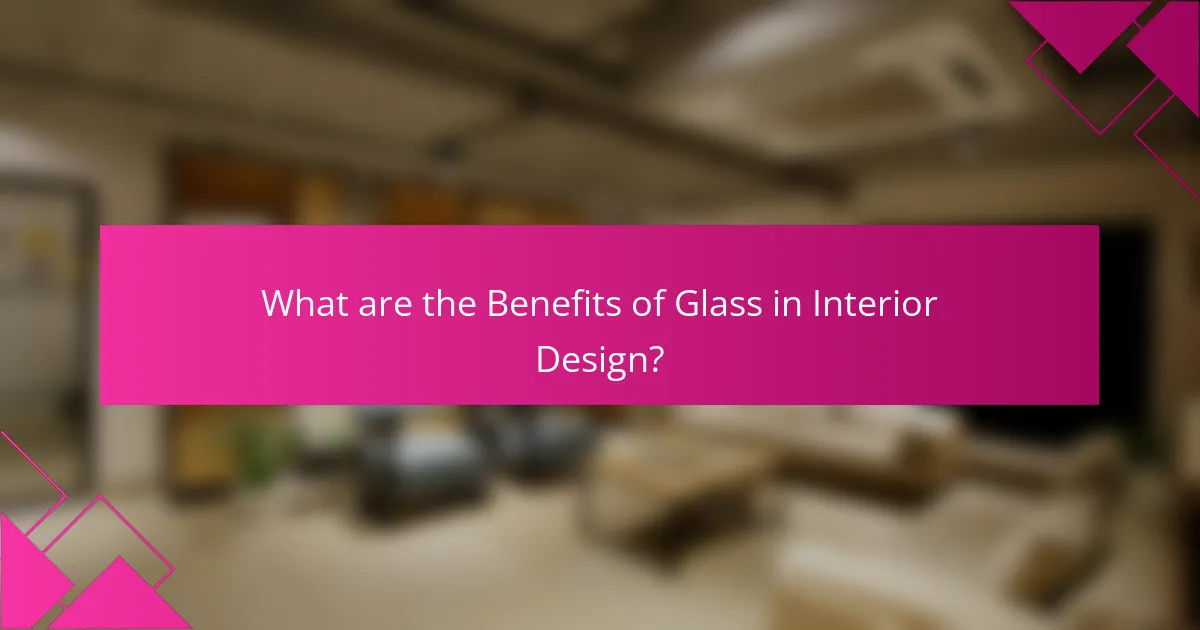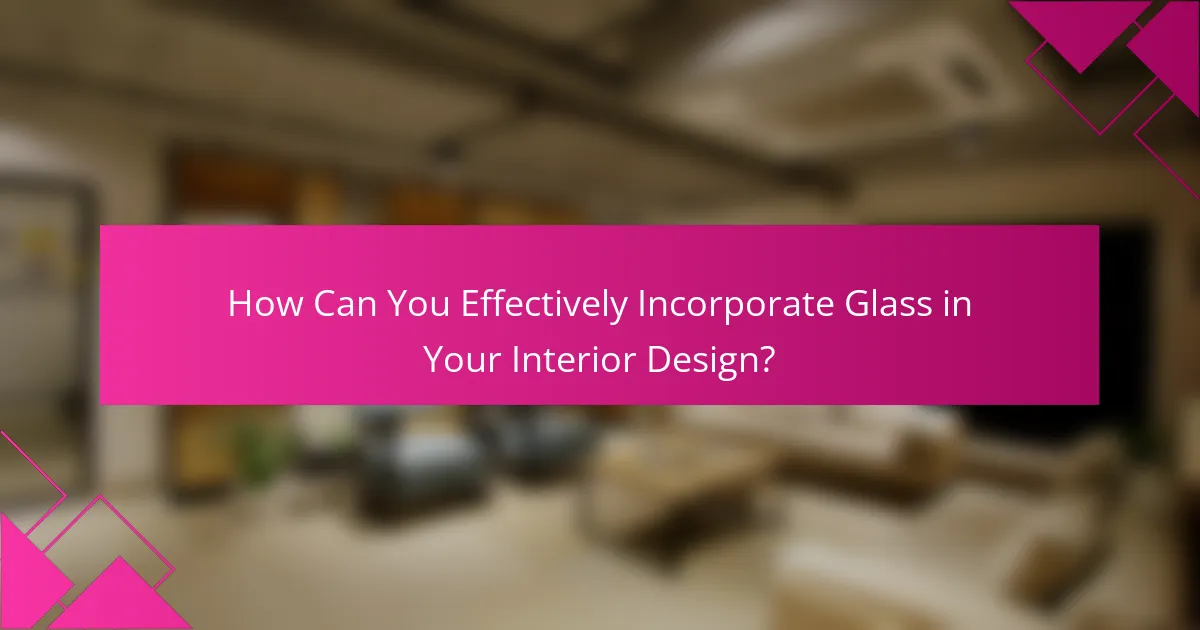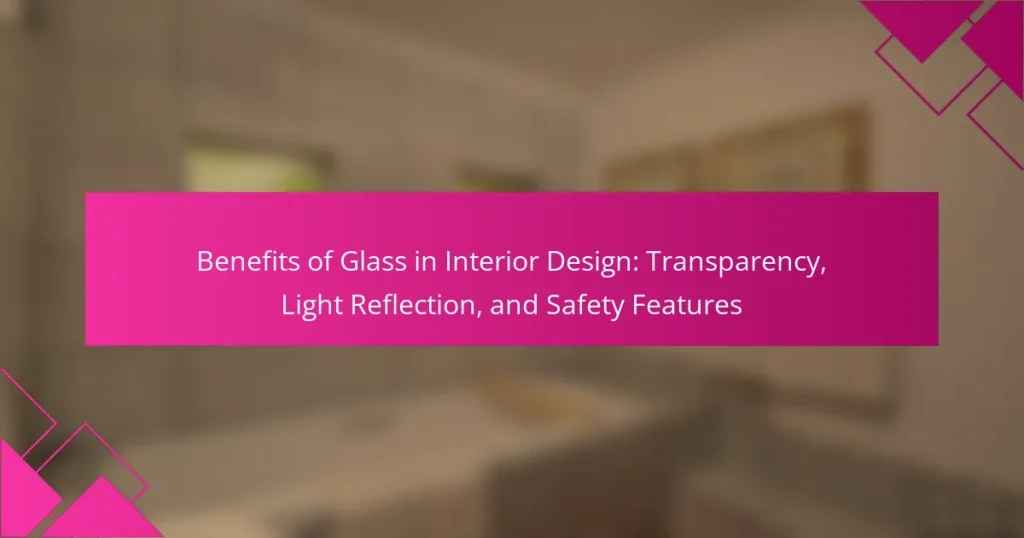Glass is a versatile material widely used in interior design, valued for its transparency, light reflection, and safety features. It enhances the flow of natural light, creating an open and airy atmosphere while making spaces appear larger and more vibrant. Glass can be incorporated in various forms, including windows, partitions, and furniture, allowing for aesthetic flexibility across different design styles. Additionally, safety features such as tempered glass improve durability and reduce risks, making it a practical choice for modern interiors. This article explores the benefits of using glass in interior design, highlighting its unique attributes and practical applications.

What are the Benefits of Glass in Interior Design?
Glass in interior design offers numerous benefits. It enhances transparency, allowing natural light to flow through spaces. This creates an open and airy feel in rooms. Glass also reflects light, which can make spaces appear larger and more vibrant. Furthermore, it provides a modern aesthetic that can elevate design appeal. Safety features, such as tempered glass, enhance durability and minimize risks. Additionally, glass is versatile, suitable for various applications like windows, partitions, and furniture. Its low maintenance requirements make it a practical choice for interior spaces.
How does Transparency in Glass Enhance Interior Spaces?
Transparency in glass enhances interior spaces by allowing natural light to flow freely. This creates an open and airy atmosphere. Increased light improves mood and productivity. Transparency also visually connects different areas within a space. It can make smaller rooms appear larger by reducing visual barriers. Additionally, glass can frame views of the outdoors, bringing nature inside. Studies show that natural light can reduce stress and increase overall well-being. Therefore, using transparent glass in design contributes significantly to a positive interior environment.
What are the visual effects of transparency in glass design?
Transparency in glass design creates a sense of openness and spaciousness. It allows natural light to penetrate spaces, enhancing brightness. The visual effect includes the ability to blur boundaries between indoor and outdoor environments. This effect fosters a connection with nature, promoting a calming atmosphere. Transparency also enables the display of architectural elements, adding aesthetic value. Additionally, it can create interesting reflections and refractions, contributing to dynamic visual experiences. Studies show that spaces with transparent elements can feel larger and more inviting, improving overall ambiance.
How does transparency influence the perception of space?
Transparency enhances the perception of space by creating an illusion of openness. It allows light to pass through, making areas appear larger and more inviting. When transparency is utilized in design, it minimizes visual barriers. This leads to a seamless flow between different spaces. Studies show that transparent materials can reduce feelings of confinement. For instance, spaces with glass walls are often perceived as more expansive. Additionally, transparency can increase natural light, further contributing to a sense of airiness. Overall, transparency plays a crucial role in shaping how individuals experience and interact with their environment.
What Role Does Light Reflection Play in Glass Design?
Light reflection plays a crucial role in glass design by enhancing aesthetics and functionality. It influences how light interacts with glass surfaces. This interaction can create visual effects that enhance the space’s ambiance. For instance, reflective glass can amplify natural light, making interiors feel more spacious. Additionally, light reflection can reduce glare, improving comfort in living and working environments. Research indicates that reflective surfaces can increase energy efficiency by reducing the need for artificial lighting. Overall, light reflection is essential in creating visually appealing and functional glass designs.
How does light reflection affect ambiance in a room?
Light reflection significantly influences the ambiance in a room. It enhances brightness and creates a sense of spaciousness. Reflective surfaces, such as glass and mirrors, bounce light around the space. This distribution of light can soften shadows and reduce harsh contrasts. Rooms with ample light reflection often feel more inviting and energetic. Studies show that well-lit environments can improve mood and productivity. For instance, a study published in the Journal of Environmental Psychology found that natural light positively affects well-being. Therefore, incorporating reflective elements can transform the overall atmosphere of a room.
What are the energy efficiency benefits of reflective glass?
Reflective glass enhances energy efficiency by reducing heat gain in buildings. It reflects a significant portion of solar radiation away from interiors. This leads to lower cooling costs during hot weather. Reflective glass can reduce energy consumption by up to 30% compared to standard glass. It also minimizes glare, improving comfort for occupants. Additionally, reflective glass can prolong the lifespan of HVAC systems. By maintaining stable indoor temperatures, it reduces the workload on heating and cooling systems. This contributes to overall energy savings and sustainability.
How Does Glass Contribute to Safety Features in Interior Design?
Glass enhances safety features in interior design through its strength and visibility. Laminated glass can withstand impact, reducing the risk of shattering. This type of glass consists of two layers with a plastic interlayer, providing added security. Tempered glass is another option, which is heat-treated to increase strength. It breaks into small, blunt pieces, minimizing injury risks. Additionally, glass railings offer unobstructed views while ensuring safety on staircases and balconies. The transparency of glass allows for better visibility in spaces, reducing accidents. Properly designed glass installations can also comply with safety codes, ensuring a secure environment.
What types of safety glass are used in interior design?
Laminated glass and tempered glass are the primary types of safety glass used in interior design. Laminated glass consists of two or more layers of glass bonded together with an interlayer. This interlayer provides additional strength and holds the glass together when shattered. Tempered glass is heat-treated to increase its strength. It shatters into small, blunt pieces, reducing the risk of injury. Both types are widely used in applications such as shower doors, partitions, and railings. Their use enhances safety while maintaining aesthetic appeal in interior spaces.
How do safety features in glass enhance user protection?
Safety features in glass enhance user protection by reducing the risk of injury from breakage. Laminated glass contains a layer of plastic between two glass panes. This design prevents shards from scattering upon impact. Tempered glass is treated to withstand high stress and is less likely to shatter. When it does break, it crumbles into small, blunt pieces. These characteristics minimize the potential for cuts and injuries. Additionally, safety glass is often used in areas prone to accidents, such as shower doors and glass railings. Regulations, such as those from the American National Standards Institute (ANSI), mandate the use of safety glass in specific applications. This ensures a higher level of safety for users in various environments.

What Are the Unique Attributes of Glass in Interior Design?
The unique attributes of glass in interior design include transparency, light reflection, and versatility. Transparency allows for visual connectivity between spaces. It enhances openness and creates a sense of spaciousness. Light reflection contributes to the brightness of interiors. Glass surfaces can amplify natural light, reducing the need for artificial lighting. Versatility enables glass to be used in various forms, such as windows, partitions, and decorative elements. Its ability to be molded and treated adds to its aesthetic appeal. Additionally, glass can incorporate safety features like tempered and laminated varieties. These attributes make glass a popular choice in modern interior design.
What Types of Glass are Commonly Used in Interior Design?
Common types of glass used in interior design include tempered glass, laminated glass, and frosted glass. Tempered glass is known for its strength and safety features. It undergoes a heating and cooling process that increases its durability. Laminated glass consists of two or more layers of glass with a plastic interlayer. This type offers sound insulation and safety, as it holds together when shattered. Frosted glass provides privacy while allowing light to pass through. It is commonly used in bathrooms and office spaces. Additionally, clear glass is widely utilized for windows and doors. Clear glass maximizes natural light and enhances visibility. Each type serves distinct purposes in interior design, contributing to aesthetics and functionality.
How do different glass types vary in style and function?
Different glass types vary significantly in style and function. Common types include tempered, laminated, and frosted glass. Tempered glass is strong and shatter-resistant, making it ideal for safety applications. Laminated glass consists of layers that provide sound insulation and UV protection. Frosted glass offers privacy while allowing light to filter through. Each type serves distinct purposes in interior design. For example, tempered glass is often used in shower enclosures. Laminated glass is popular in windows for its safety and energy efficiency. Frosted glass is frequently employed in office partitions. The choice of glass type impacts both aesthetics and functionality in design.
What are the benefits of tempered versus laminated glass?
Tempered glass is stronger and more heat-resistant than laminated glass. It undergoes a heating and cooling process that increases its strength. This makes tempered glass less likely to break under stress. When it does break, it shatters into small, blunt pieces, reducing injury risk.
Laminated glass consists of two or more layers of glass with a plastic interlayer. This design enhances safety by holding shattered glass in place. Laminated glass also provides better sound insulation compared to tempered glass. Furthermore, it offers UV protection, blocking up to 99% of harmful rays.
Both types of glass serve distinct purposes in interior design. Tempered glass is ideal for high-stress applications like shower doors and glass railings. Laminated glass is preferable for windows and skylights where safety and sound reduction are priorities. Each type’s unique properties cater to specific design needs and safety requirements.
What Innovative Applications of Glass are Emerging in Interior Design?
Innovative applications of glass in interior design include smart glass, glass walls, and glass furniture. Smart glass can change transparency with electrical signals, enhancing privacy and energy efficiency. Glass walls create open spaces while maintaining structural integrity. Glass furniture, such as tables and shelves, adds elegance and a sense of spaciousness. These applications leverage the properties of glass to improve aesthetics and functionality in modern interiors.
How is smart glass changing the landscape of interior spaces?
Smart glass is transforming interior spaces by enhancing privacy and energy efficiency. It can switch from transparent to opaque with the touch of a button. This feature allows for customizable environments in homes and offices. Smart glass reduces the need for traditional window treatments. It also helps regulate indoor temperatures, minimizing energy costs. Studies show that smart glass can save up to 30% on heating and cooling expenses. Furthermore, it provides protection from harmful UV rays while maintaining natural light. This innovation is reshaping modern interior design by combining functionality with aesthetics.
What are the latest trends in glass usage for interior aesthetics?
The latest trends in glass usage for interior aesthetics include the use of large glass panels and partitions. These elements create an open and airy feel in spaces. Additionally, frosted and textured glass is gaining popularity for privacy while still allowing light to pass through. Smart glass technology is also emerging, enabling users to adjust transparency with a switch. Furthermore, colored glass accents are being incorporated for artistic flair. Glass shelving and furniture pieces are trending, providing modern and sleek designs. These trends reflect a growing preference for minimalism and functionality in interior design.

How Can You Effectively Incorporate Glass in Your Interior Design?
To effectively incorporate glass in your interior design, utilize it in various forms such as windows, doors, and partitions. Glass enhances natural light, creating a bright and open atmosphere. Consider using glass furniture like tables or shelves to maintain a light aesthetic. Glass can also serve as a decorative element through mirrors or art installations. Incorporating frosted or textured glass adds privacy while still allowing light to pass through. Use glass in combination with other materials for contrast and depth in design. The versatility of glass allows it to fit various styles, from modern to traditional. This adaptability makes glass an essential component in contemporary interior design.
What Best Practices Should Be Followed When Using Glass in Interiors?
When using glass in interiors, prioritize safety, aesthetics, and functionality. Use tempered or laminated glass for safety, as these types are less likely to shatter. Incorporate glass in ways that enhance natural light, such as large windows or glass doors. Ensure proper installation to avoid leaks and structural issues. Select appropriate thickness based on the application to maintain durability. Optimize visibility by keeping glass clean and well-maintained. Consider using frosted or tinted glass for privacy while still allowing light. Lastly, adhere to local building codes and regulations to ensure compliance and safety.
How can you ensure safety when installing glass features?
To ensure safety when installing glass features, use tempered or laminated glass. Tempered glass is heat-treated to withstand impact and reduce shattering risks. Laminated glass consists of layers bonded with a plastic interlayer, preventing shards from scattering. Always follow manufacturer guidelines for installation. Use proper support structures to hold the glass securely. Employ safety gear, such as gloves and goggles, during installation. Ensure the installation area is clear of obstacles and distractions. Regularly inspect glass features for any signs of wear or damage. These practices significantly reduce the risk of accidents and injuries associated with glass installations.
What maintenance tips should be considered for glass surfaces?
Clean glass surfaces regularly using a soft cloth. Use a pH-neutral cleaner to avoid damage. For tough stains, a mixture of vinegar and water works effectively. Avoid abrasive materials that can scratch the glass. Wipe in a circular motion to prevent streaks. Use a squeegee after washing to remove excess water. Ensure to clean both sides of the glass for optimal clarity. Regular maintenance enhances the longevity and appearance of glass surfaces.
What Common Challenges Might You Face with Glass in Interior Design?
Common challenges with glass in interior design include fragility, maintenance, and thermal performance. Glass is prone to breakage, which can pose safety risks. Regular cleaning is required to maintain clarity and prevent smudges. Additionally, glass can have poor insulation properties, leading to energy loss. It may also create glare issues, affecting comfort in bright environments. Finally, the weight of large glass panels can complicate installation and structural support. These factors must be carefully considered during design to ensure functionality and safety.
How can you address issues related to glare and privacy?
To address issues related to glare and privacy, use window treatments such as blinds or shades. These can effectively reduce glare from sunlight. Additionally, consider using tinted or frosted glass. Tinted glass minimizes glare while maintaining privacy. Frosted glass obscures visibility while allowing natural light. Another option is to install window films that provide glare reduction and privacy. Plants or screens can also be placed outside windows for added privacy. Each of these solutions enhances comfort while preserving the benefits of glass in interior design.
What solutions exist for thermal insulation with glass installations?
Solutions for thermal insulation with glass installations include double glazing, low-emissivity (Low-E) coatings, and insulated glass units (IGUs). Double glazing consists of two glass panes separated by a space filled with argon or krypton gas. This design reduces heat transfer significantly compared to single-pane glass. Low-E coatings reflect heat back into the room while allowing light to pass through. This enhances energy efficiency in buildings. Insulated glass units combine these technologies to create a barrier against thermal loss. They can achieve U-values as low as 0.2 W/m²K, indicating high insulation performance. These solutions are widely used in modern architecture to improve energy efficiency and comfort in living spaces.
The main entity of the article is glass in interior design, which offers significant benefits through its attributes of transparency, light reflection, and safety features. The article outlines how glass enhances natural light flow, creates an open atmosphere, and visually connects spaces, while also providing energy efficiency and reducing glare. It discusses various types of glass, such as tempered and laminated glass, emphasizing their safety characteristics and applications. Additionally, the article covers innovative uses of glass, best practices for incorporation, and solutions to common challenges, ensuring a comprehensive understanding of glass’s role in modern interior design.


